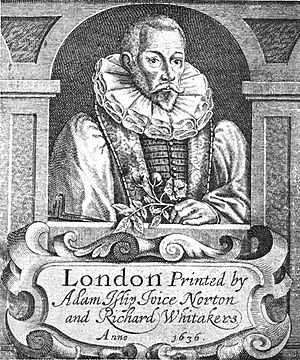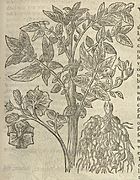John Gerard facts for kids
Quick facts for kids
John Gerard
|
|
|---|---|

Frontispiece of 1636 edition of Herball
|
|
| Born | 1545 Nantwich, Cheshire, England
|
| Died | 1612 (aged 66–67) London, England
|
| Resting place | St Andrews, Holborn |
| Other names | John Gerarde |
| Known for | The book Herball, or Generall Historie of Plantes |
| Scientific career | |
| Fields | Botany |
| Author abbrev. (botany) | J.Gerard |
John Gerard (born around 1545, died 1612) was an English expert on plants, known as a herbalist. He had a very large garden in Holborn, which is now part of London. His most famous book was called Herball, or Generall Historie of Plantes. It was first published in 1597 and had 1,484 pages with many pictures. This book became very popular for gardening and learning about plants in the 1600s.
Gerard's Herball was mostly an English translation of an older book by Rembert Dodoens from 1554. Dodoens' book was popular in many languages. Gerard added some plants from his own garden and new ones from North America. The pictures in Gerard's book mostly came from other European books. However, the title page had a special original drawing by William Rogers. About 20 years after Gerard died, his book was updated and made even bigger, with around 1,700 pages.
Contents
John Gerard's Life Story
Early Life and Learning
John Gerard was born in Nantwich, England, in late 1545. He went to school in nearby Willaston. We don't know much about his parents.
When he was about 17, in 1562, he started training to be a barber-surgeon in London. This was with a group called the Barber-Surgeon's Company. His teacher, Alexander Mason, was a very skilled surgeon. John Gerard did well in his training. In 1569, he was allowed to open his own practice.
Gerard said he learned a lot about plants by traveling to other countries. But it seems he only made one trip abroad when he was younger. He might have worked on a merchant ship sailing around the North Sea and Baltic. He wrote about visiting places like Scandinavia and Russia.
Family and Later Years
John Gerard married a woman named Anne (or Agnes), who passed away in 1620. They had five children, but only one, Elizabeth, lived longer than them.
He lived his whole adult life in London, near a place called Barnards Inn. He probably lived in a house with a garden that belonged to a nobleman named Lord Burghley. John Gerard died in February 1612 and was buried at St Andrews, Holborn church in London. His grave does not have a marker.
Gerard's Career and Gardens
John Gerard had a very successful career with the Barber-Surgeons' Company. He became a member of their board of directors in 1595. In 1607, he was even chosen to be the Master of the company, which was a very important position.
While he was studying, he started a garden at his home in Holborn, London. He often wrote about this garden in his books. He even published a list of the plants growing there. This garden became famous, and people from all over the world sent him seeds and plants. He also got offers to look after the gardens of important noblemen.
In 1577, he started working as the superintendent (manager) of the gardens for William Cecil, 1st Baron Burghley (who was the Queen's chief treasurer). He worked there for over 20 years. In 1586, he also became the curator (manager) of a special plant garden for the Royal College of Physicians. He held this job until 1604.
Gerard was known as a very skilled herbalist. He spent a lot of time working in his Holborn garden and for Lord Burghley. He was also given a garden near Somerset House by Queen Anne, the wife of King James I.
John Gerard was more of a practical gardener than a scholar. He had many important friends who also loved plants. They would often trade plants with each other. He even got rare plants from South America and the Middle East. He also visited other famous gardens, like those at St. James and Hampton Court. His servant traveled to the Mediterranean to find plants for him, and the French king's gardener sent him seeds.
John Gerard's Important Works
The Plant Catalogue of 1596
In 1596, Gerard published a book called Catalogue of Plants. This book listed 1,039 rare plants that he grew in his garden in Holborn. He brought many new plants from the New World to England. For example, he introduced a plant he mistakenly called Yucca. The Yucca didn't bloom while he was alive, but a piece from it bloomed later for someone else. Today, the Yucca plant still has the name Gerard gave it.
This list was the first of its kind ever made. Only one copy of this book is known to exist today. It is kept in the Sloane collection at the British Library. A friend of Gerard's, L'Obel, wrote the introduction to the book. People were amazed at how many strange and rare plants Gerard had in his garden.
The Famous Herball of 1597
The publisher John Norton asked Gerard to translate a popular plant book by Rembert Dodoens into English. This book was called Stirpium historiae pemptades sex (1583). It was a Latin version of Dodoens' earlier Dutch book, Cruydeboeck (Herb Book, 1554). An English version of Dodoens' book was already popular, translated by Henry Lyte in 1578.
Gerard was not the first person asked to do this translation. Another doctor, Robert Priest, had started the work but died. Gerard used much of Priest's work. He also added notes from his own garden and included some plants from North America for the first time in an English book. For example, he gave the first English description of the potato. He thought it came from Virginia, but it actually came from South America.
Gerard also used some unpublished information from L'Obel and other botanists. He arranged the book to look like L'Obel's work, which might have been a way to hide where the original information came from.
In the introduction to his book, Gerard said that the work was his own. He mentioned that Doctor Priest had started a translation but died before finishing it. Because of this, some people accused Gerard of copying other people's work without giving them credit.
Despite these issues, Gerard's Great Herball, or, Generall Historie of Plantes was published in 1597. It used hundreds of woodblock pictures from other plant books. Gerard's book included over 1,000 plants in 167 chapters. It also had some incorrect or mythical information, like the story of a tree that grew geese.
Even with its mistakes, the Herball was very popular. It gave information in English about the names, habits, and uses of many plants, both common and rare. For a long time, it was seen as the best and most complete book of its kind.
John Gerard's Lasting Impact
After John Gerard died in 1612, his Herball was updated and corrected. A new edition came out in 1633, and another in 1636. These were edited by Thomas Johnson, a botanist from London. Johnson added over 800 new plant types and 700 new pictures. He also made many corrections to Gerard's original work. Johnson's updated versions are the most well-known today.
John Gerard is seen as one of the people who helped start the study of plants in the English language. Even though he wasn't a highly educated scholar, he was very interested in the medicinal uses of plants. Some critics at the time, like John Ray, said that Gerard's book had problems because he didn't know foreign languages well enough to translate the original work properly.
However, because the Herball was practical, full of helpful pictures, and written in a lively way, it was very popular with everyday people in England in the 1600s. Even in the early 1800s, people were still using the Herball as a guide for treating illnesses with plants.
The famous scientist Linnaeus honored Gerard by naming a plant species Gerardia after him. Gerard's Herball also mentions many poisonous plants that appear in Shakespeare's plays. This has made the book valuable to people who study literature. For example, the herb that makes Juliet fall into a death-like sleep in Shakespeare's play might be one of the plants described in the Herball, like nightshade or Mandragora. Some historians even think that Shakespeare himself might be shown on the title page of the Herball.
John Gerard was part of an early group of natural historians during the Renaissance. These scholars started to describe the natural world by observing it directly, instead of just copying old texts. Gerard's Herball, like those by Dodoens and other herbalists, was based on the ancient text De Materia Medica by Dioscorides. But it also included new information from Gerard's friends and other botanists like Leonard Fuchs (after whom Fuchsia is named) and L'Obel (after whom Lobelia is named). These botanists were well-educated and studied plants through direct observation. Gerard and L'Obel were friends and sometimes went on trips together to find plants.
In 1897, a plant genus from South Africa called Gerardiina was also named after John Gerard.



